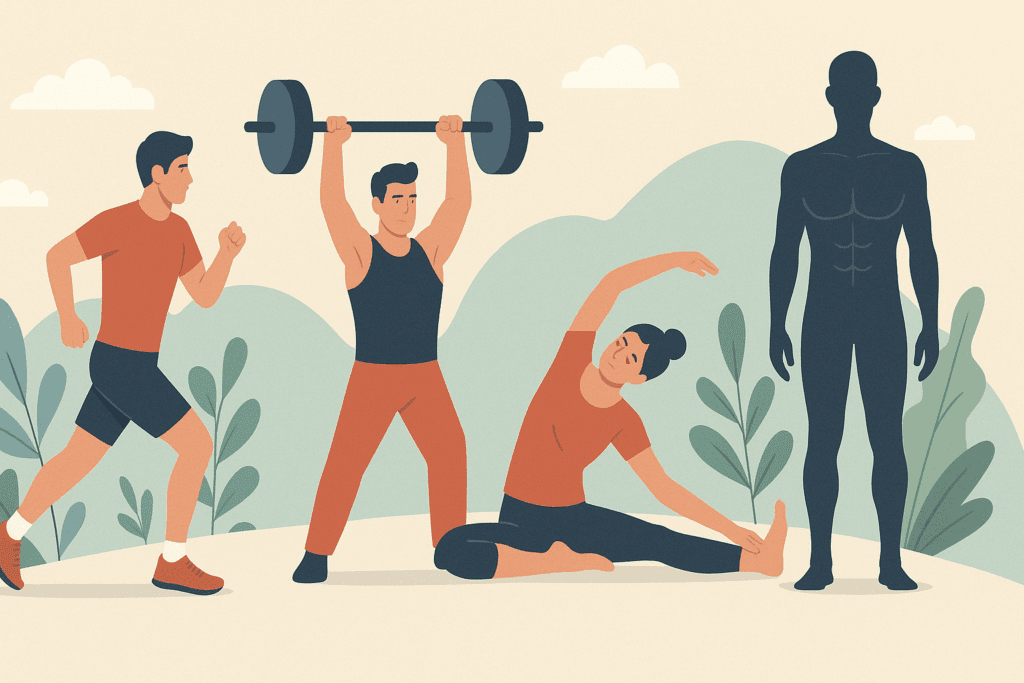Introduction: The Essential Role of Fitness in Performance and Longevity
In an era where wellness is no longer a trend but a lifestyle imperative, the link between health-related fitness and enhanced physical performance has never been more significant. Whether you’re a professional athlete, weekend warrior, or simply someone striving to stay energized throughout the day, building endurance and stamina through strategic physical conditioning is a cornerstone of sustainable well-being. These two facets of physical capability form the very foundation of our ability to move, exert force, resist fatigue, and recover with efficiency and strength. When properly understood and cultivated, health-related fitness transcends aesthetics or short-term athletic gains—it becomes an investment in your physiological resilience, cardiovascular health, and overall quality of life.
You may also like: How to Increase Stamina and Endurance Naturally: Smart Training Tips and Nutrition Habits That Support Cardiovascular Fitness
Today’s conversation around performance enhancement is deeply rooted in scientific principles and personalized approaches that adapt to individual baselines and goals. This transformation reflects a growing understanding that physical fitness and conditioning are not one-size-fits-all pursuits but dynamic practices that evolve over time. From optimizing muscular strength to refining energy metabolism and boosting mental clarity, the benefits of structured, evidence-based fitness programs are vast. Within this context, endurance and stamina emerge not as optional attributes but as vital capacities that determine how well—and how long—you can perform in any given task, from high-intensity workouts to daily physical activity.
As we explore the relationship between health-related fitness, physical fitness and conditioning, and the natural enhancement of stamina and endurance, it’s important to ground our insights in medically sound, experientially informed, and ethically responsible guidance. Drawing on the principles of EEAT—Experience, Expertise, Authoritativeness, and Trustworthiness—this article aims to empower readers with comprehensive, credible, and actionable information. With that foundation, let us dive into the interconnected science and strategy behind maximizing your performance through intelligent, purposeful fitness conditioning.

Understanding Health-Related Fitness: More Than Muscle and Motion
Health-related fitness is a multifaceted concept that goes beyond the superficial metrics often associated with gym routines and body composition goals. At its core, it refers to the components of fitness that directly impact your long-term health and functional ability. These include cardiovascular endurance, muscular strength and endurance, flexibility, and body composition. Unlike skill-related fitness, which focuses on attributes like agility and coordination, health-related fitness emphasizes capacities that sustain vitality and protect against chronic disease.
Each of these components plays a unique and indispensable role in your physiological ecosystem. Cardiovascular endurance, for example, supports the heart and lungs’ efficiency in delivering oxygen to working muscles, which is essential for maintaining energy levels during prolonged activity. Muscular strength and endurance enhance your ability to lift, push, pull, and resist fatigue across a range of daily movements. Flexibility, often underestimated, ensures that your joints move freely and efficiently, reducing the risk of injury and allowing for smoother motion patterns. Lastly, a balanced body composition—specifically, an optimal ratio of lean muscle to body fat—can significantly influence metabolic health, hormonal balance, and even mental clarity.
Importantly, health-related fitness isn’t static. It responds dynamically to lifestyle choices, training protocols, nutritional intake, and recovery habits. This means that whether you’re starting from a place of inactivity or are already physically active, you have the agency to influence and enhance these components over time. The synergy among them is what ultimately contributes to your capacity for improved stamina and lasting endurance, laying the groundwork for physical resilience and peak performance.

The Science of Physical Fitness and Conditioning for Endurance Development
To appreciate the full impact of physical fitness and conditioning on endurance, it’s essential to understand the physiological adaptations that occur through consistent training. Conditioning involves systematically subjecting the body to physical stress in a controlled manner, prompting adaptations in the muscular, cardiovascular, and nervous systems. These adaptations are not only crucial for athletic performance but also for enhancing everyday function and resisting the wear and tear of aging and stress.
Cardiovascular adaptations are among the most significant when it comes to endurance. Regular aerobic training, such as running, cycling, or swimming, strengthens the heart muscle, lowers resting heart rate, increases stroke volume (the amount of blood pumped per beat), and enhances capillary density in working muscles. These changes collectively enable your body to deliver and utilize oxygen more efficiently, which is a key determinant of aerobic stamina. Muscular endurance also improves as a result of conditioning, with muscle fibers developing a greater capacity to store glycogen, resist lactic acid buildup, and generate ATP (adenosine triphosphate) through aerobic pathways.
Neuromuscular adaptations further support endurance by enhancing motor unit recruitment, coordination, and fatigue resistance. As the nervous system becomes more efficient in sending signals to muscles, your movement becomes more economical, reducing the energy cost of repetitive actions. Meanwhile, mitochondrial biogenesis—the increase in number and efficiency of mitochondria within muscle cells—amplifies the body’s ability to produce sustained energy over long durations.
These changes don’t happen overnight but are the cumulative result of strategically applied training principles: specificity, progressive overload, recovery, and variation. Whether you’re building toward a marathon, increasing your energy for work and family life, or seeking greater functional capacity, a well-rounded conditioning program is the key to unlocking superior endurance and stamina naturally.

Designing a Sustainable Fitness Program for Lasting Performance Gains
Creating a fitness program that fosters both endurance and stamina requires intentional planning, flexibility, and a deep understanding of your personal baseline and goals. It’s not about punishing intensity or quick fixes but rather about consistent, intelligent progression that honors your body’s signals and recovery needs. The process begins with an assessment of current fitness levels, including cardiovascular capacity, muscular strength, mobility, and body composition. From this foundation, you can identify specific areas for improvement and begin crafting a structured approach.
An effective program for boosting endurance will often integrate a variety of training modalities, including aerobic workouts, strength training, mobility drills, and recovery practices. Aerobic exercise remains central for building cardiovascular endurance, but variation in intensity—through interval training, tempo runs, or hill repeats—can stimulate greater adaptation and avoid plateaus. Strength training, too, is essential, not just for muscle hypertrophy but for improving muscular endurance and joint stability, which contribute to sustained performance under physical stress.
Mobility and flexibility work often take a backseat in many fitness routines, yet they are essential for ensuring full range of motion and reducing injury risk. Incorporating practices like dynamic stretching, yoga, or foam rolling can support better movement mechanics and prevent muscular imbalances. Likewise, adequate recovery—including sleep, hydration, nutrition, and active rest days—is foundational for allowing the body to repair and grow stronger between sessions.
Tracking progress over time with measurable benchmarks—such as VO2 max tests, heart rate variability, or personal performance goals—can help maintain motivation and provide valuable feedback on the effectiveness of your approach. The ultimate goal is to establish a sustainable routine that becomes part of your lifestyle, supporting long-term health-related fitness and enabling consistent physical performance regardless of age or background.

Natural Strategies for Enhancing Stamina Without Overreliance on Stimulants
While it’s tempting to reach for energy drinks or pre-workout supplements in the pursuit of stamina, these solutions often provide temporary boosts at the expense of long-term well-being. Fortunately, there are several natural, evidence-based strategies that can significantly elevate your energy and endurance levels without overstimulating the nervous system or disrupting hormonal balance. These approaches emphasize internal regulation, physiological support, and holistic self-care.
One of the most powerful yet overlooked methods is breathwork. Controlled breathing techniques, such as diaphragmatic breathing or the Buteyko method, can enhance oxygen uptake and CO2 tolerance, directly influencing stamina. Elite athletes often incorporate breath control in their routines to delay fatigue, improve mental focus, and optimize cardiovascular efficiency. Integrating conscious breathwork into training or daily life can yield profound improvements in energy regulation.
Nutrition also plays a critical role in endurance. Complex carbohydrates provide a steady release of glucose, fueling prolonged activity, while healthy fats support long-duration efforts by offering a dense, slow-burning energy source. Micronutrients such as iron, magnesium, and B vitamins are indispensable for mitochondrial function and red blood cell production, both of which directly influence how well oxygen is delivered and utilized by the muscles. Hydration is equally vital; even mild dehydration can impair performance and accelerate fatigue.
Mind-body practices such as meditation, tai chi, and restorative yoga contribute to stamina by enhancing mental resilience and reducing stress-related energy depletion. Chronic stress is a hidden saboteur of endurance, undermining recovery and increasing cortisol levels. By cultivating a calm, regulated nervous system, you create an internal environment more conducive to sustained physical output. Sleep, often underestimated, is the ultimate performance enhancer, promoting hormonal regulation, tissue repair, and cognitive clarity.
Incorporating these natural strategies into a broader regimen of physical fitness and conditioning provides a multifaceted approach to building stamina. Rather than relying on short-term hacks, you’re fostering an internal environment of energy efficiency, adaptability, and long-term vitality.

The Psychological Edge: Building Mental Endurance Through Physical Training
Physical fitness and conditioning are not just about strengthening the body—they also provide a powerful platform for cultivating mental toughness and emotional resilience. The link between physical training and psychological endurance is well-documented in sports psychology and cognitive neuroscience, revealing that consistent exercise can rewire neural pathways associated with stress response, motivation, and focus. In the pursuit of health-related fitness, this mental dimension is often the secret ingredient behind breakthrough performance.
Endurance training, by its very nature, requires sustained focus and discomfort tolerance. Whether you’re running a long-distance race or engaging in high-rep strength circuits, your ability to maintain effort despite fatigue becomes a mental game. Over time, this practice develops grit, patience, and goal-oriented thinking—qualities that translate well beyond the gym and into professional and personal domains. Structured physical routines instill discipline and time management, reinforcing the cognitive habits that support sustained performance.
Moreover, physical activity enhances mood and emotional stability through the release of endorphins, dopamine, and serotonin—neurotransmitters linked to pleasure, motivation, and well-being. These chemical shifts not only reduce anxiety and depression symptoms but also elevate your capacity for stress recovery, allowing you to bounce back from setbacks more quickly. This resilience is essential in endurance training, where plateaus and challenges are inevitable.
Mindset training can be further augmented through practices like visualization, positive self-talk, and goal setting. Elite performers often rehearse success mentally before it happens physically, creating a neurological blueprint for achievement. When integrated with a robust fitness and conditioning program, these psychological techniques amplify both stamina and performance outcomes, creating a feedback loop of physical and mental empowerment.
Ultimately, building mental endurance is not about suppressing discomfort or pretending fatigue doesn’t exist—it’s about developing the mindset to navigate those moments with intention, clarity, and confidence. This psychological edge, born of consistent training and self-awareness, becomes one of the most enduring assets in your pursuit of performance excellence.

Frequently Asked Questions (FAQ)
How does emotional well-being influence physical fitness and conditioning outcomes? Emotional well-being significantly impacts the effectiveness of physical fitness and conditioning programs, often more than people realize. Elevated stress levels can impair muscle recovery, reduce motivation, and even suppress immune function, all of which can hinder your physical progress. Conversely, individuals with strong emotional health often demonstrate better consistency, higher pain tolerance, and a more positive response to challenging workouts. Developing emotional resilience can indirectly enhance health related fitness by supporting long-term behavioral adherence and recovery efficiency. When mental and emotional factors are balanced, physical gains in stamina and endurance become more attainable and sustainable.
Can technology improve how we approach health related fitness? Yes, technological tools are rapidly transforming how we approach health related fitness and training personalization. Wearable fitness trackers now offer precise insights into heart rate variability, sleep patterns, and recovery metrics—data that helps optimize physical fitness and conditioning strategies. Apps that deliver customized workout plans or track progressive overload over time have also made it easier for users to engage with consistent, goal-oriented routines. Virtual coaching and AI-driven platforms are expanding access to high-level programming traditionally reserved for elite athletes. By integrating these tools, individuals can fine-tune their approach to fitness in ways that were previously unavailable, ensuring each session contributes meaningfully to long-term endurance goals.
What is the role of muscle memory in improving stamina naturally? Muscle memory plays a key role in enhancing stamina and performance through more efficient movement patterns and quicker neurological adaptation. Once the body has learned a physical skill or routine, it can re-adopt it more quickly—even after periods of inactivity. This neurological imprinting supports long-term physical fitness and conditioning by reducing the time needed to rebuild strength or stamina after breaks. Athletes who return from injury or seasonal rest periods often rely on muscle memory to regain their performance baseline faster. In this way, maintaining a history of regular movement contributes indirectly to overall health related fitness by preserving foundational motor patterns.
Are there gender-specific considerations when building endurance through conditioning? Absolutely. Gender-related physiological differences such as hormone levels, muscle fiber distribution, and aerobic capacity can influence how individuals respond to different conditioning protocols. For instance, women generally have a higher proportion of Type I (slow-twitch) muscle fibers, which may enhance endurance performance but require a slightly different approach to strength training. Men, on the other hand, may experience faster muscle hypertrophy and strength gains, affecting how physical fitness and conditioning programs should be structured for long-term results. These biological nuances don’t limit potential but instead suggest the need for nuanced, individualized program design that supports both men and women in optimizing their health related fitness outcomes.
What are some early signs of overtraining when pursuing endurance goals? Overtraining is a common pitfall for individuals intensely pursuing increased stamina without adequate recovery. Early signs may include persistent fatigue, sleep disturbances, elevated resting heart rate, irritability, and a plateau—or even regression—in performance. These symptoms indicate that the balance between physical fitness and conditioning efforts and rest has been disrupted. Ignoring these signs can lead to chronic stress injuries, weakened immune response, and hormonal imbalances that undermine long-term health. Listening to your body and tracking recovery metrics can ensure your health related fitness plan remains safe and productive over time.
Can you improve endurance without engaging in traditional cardio exercises? Yes, endurance can be improved through various non-traditional means beyond running or cycling. Activities such as circuit strength training, plyometric routines, and dynamic mobility sessions can also stimulate cardiovascular improvements and muscle endurance. These functional workouts, when structured appropriately, challenge both the aerobic and anaerobic energy systems, making them powerful tools in physical fitness and conditioning. Additionally, practices like hiking, rowing, or even dancing provide diverse ways to develop stamina while reducing the risk of mental burnout. For many, incorporating these alternative approaches supports health related fitness goals with greater variety and engagement.
How does aging impact the effectiveness of physical fitness and conditioning programs? Aging naturally influences muscle mass, joint mobility, cardiovascular capacity, and recovery time, but it does not prevent individuals from improving their health related fitness. In fact, physical fitness and conditioning become even more critical with age, helping mitigate declines in bone density, metabolic rate, and cognitive function. Older adults may benefit from programs that emphasize joint-friendly movements, increased recovery periods, and targeted resistance training to preserve lean mass. Maintaining flexibility, balance, and coordination through activities like Pilates or tai chi also supports endurance indirectly by improving physical efficiency. With proper adaptation, age-appropriate conditioning can yield impressive results in stamina and energy levels well into later life.
What is the role of environmental factors in conditioning for endurance? Environmental conditions—such as altitude, temperature, and humidity—can profoundly affect physical performance and how the body responds to conditioning. Training at high altitudes, for example, stimulates the production of red blood cells, thereby improving oxygen delivery and endurance capacity over time. Heat training, when done safely, can enhance thermoregulation and cardiovascular efficiency, making it useful for those preparing for events in warm climates. However, these adaptations must be approached cautiously to avoid dehydration or heat illness. Being mindful of how environmental stressors interact with your physical fitness and conditioning efforts can provide an additional layer of strategy in maximizing health related fitness.
How can occupational demands influence stamina development? Professionals with physically demanding jobs—such as first responders, healthcare workers, and manual laborers—often have unique endurance needs compared to those in sedentary roles. These individuals benefit from task-specific conditioning that mimics job demands while improving durability and recovery. For instance, incorporating load carriage exercises or prolonged standing drills can prepare the body for occupational strain without compromising overall physical fitness and conditioning. Mental fatigue also plays a role; learning to manage stress and maintain focus under pressure is essential for sustaining performance throughout long shifts. In this context, health related fitness is not only about aesthetics or performance but about ensuring safety, efficiency, and well-being in the workplace.
What are the future trends shaping the evolution of health related fitness? Emerging trends in health related fitness reflect a shift toward integrative, personalized, and tech-supported approaches. Biometric wearables are becoming more advanced, offering real-time insights into muscle oxygenation, lactate thresholds, and recovery scores. Meanwhile, integrative training philosophies are combining physical fitness and conditioning with behavioral coaching, mindfulness, and even genomic data to customize routines. There’s also a growing focus on sustainability—both in environmental terms and in creating routines people can realistically maintain for decades. The future of fitness isn’t just faster or stronger—it’s smarter, safer, and more deeply attuned to the full spectrum of human health and performance potential.
Conclusion: Elevate Your Energy and Longevity Through Smart, Natural Conditioning
In the landscape of modern wellness and performance optimization, health-related fitness and physical fitness and conditioning offer a transformative pathway to greater energy, resilience, and capacity. These aren’t just abstract ideals or athletic aspirations—they are tangible, trainable attributes that influence every facet of how you move, think, and feel. By understanding the mechanisms that support endurance and stamina, and by integrating sustainable training, nutritional strategies, recovery habits, and psychological resilience, you set the stage for a life of empowered vitality.
Importantly, enhancing stamina and endurance doesn’t require extreme interventions or constant reliance on synthetic aids. Through natural, intelligent conditioning practices and a grounded approach to health, you can unlock your body’s innate potential and perform at your best—whether in sport, work, or daily living. The fusion of evidence-based science, practical application, and self-awareness ensures that your journey toward peak performance is not only effective but also sustainable.
As you continue to explore your personal limits and potential, remember that physical fitness is not a destination but a dynamic, lifelong relationship with your body and mind. Embrace that journey with purpose, and you’ll find that the rewards—greater stamina, lasting endurance, and elevated performance—extend far beyond the physical, enriching every dimension of your well-being.
Was this article helpful? Don’t let it stop with you. Share it right now with someone who needs to see it—whether it’s a friend, a colleague, or your whole network. And if staying ahead on this topic matters to you, subscribe to this publication for the most up-to-date information. You’ll get the latest insights delivered straight to you—no searching, no missing out.
Further Reading:
How to Increase Stamina: 16 Ways to Power Up a Workout

